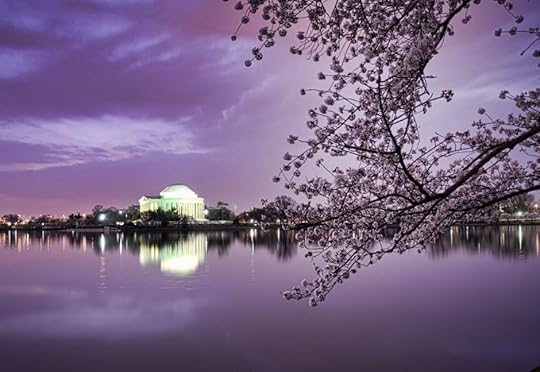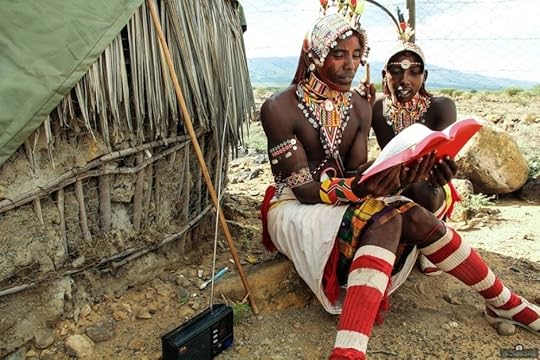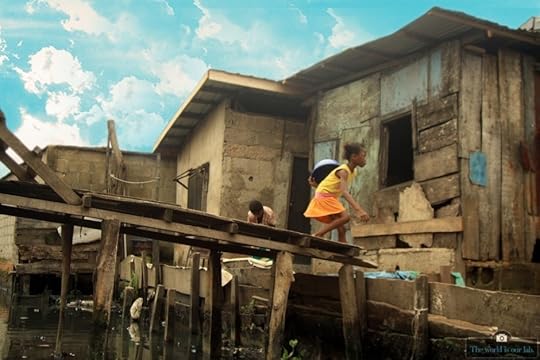Matador Network's Blog, page 2285
April 11, 2014
US companies won't ban work emails

Photo: herval
WHEN I HEARD that some companies in France were “banning” the sending and receiving of work-related emails before 9am and after 6pm, I thought, “Good for them. That will never happen in the USA.”
Try telling a New York City stockbroker to not answer a work email after 4:00pm, and see how they react. Here are five reasons why those working for US companies will likely never see restricted access to work-related communication, even after they’ve “clocked out”:
1. We are too concerned with seeming “valuable” to our companies. We don’t work longer hours because we want to – we do it because we don’t want our companies to fire us. In most cases, the person who answers a work-related email within five minutes of it being sent out, is often viewed as someone more valuable than the employee who decided to answer it the next day. When a company has to let people go, its often the employees who have taken their entitled personal time, instead of dedicating that time to their jobs, who are sacked.
2. There are other ways to get in touch with employees, outside of the workplace. Every company knows how to get in touch with their employees once they’ve shut down their computer. I’ve even had people tweet work requests to me during off-hours at my old job.
3. Our obsession with being connected is too ingrained in us. We check our work emails incessantly because we are afraid of “missing out” on important opportunities. We do the same thing with our Facebook pages, our Twitter feeds, our text messages, etc. We want to be the first to hear about what’s going on in the world, and to respond to messages in real-time. Even if a work email isn’t that important, we answer it anyway, because our our cell phones notify us when a message lands in our inbox.
4. There is always someone working, somewhere. Not all jobs are constructed within the confines of 9am-5pm. As a Social Media Manager, I have to closely monitor the social channels of Matador in case of any issues that might arise. While I’m not glued to my computer or cell phone 24/7, I do check these sites frequently, and I have to be available if something goes wrong.
5. We are always trying to be better than everyone else. “Oh, you only work 35 hours week? Yeah, we work 40.” “It’s nice that you take a siesta every day, but maybe that’s why your business is in the shitter, and our productivity has increased by 400% over the last century.”
That’s American work mentality for you. It doesn’t mean we work harder than other countries, and it also doesn’t mean that we necessarily work better, either. But the idea that we are one-upping someone is very appealing to the competitive American workforce; knowing that we have access to our work emails when other people don’t, somehow means we can maintain our “Global Superpower” status (even if our citizens are stressed out because of it). 
The post 5 reasons why American companies will never ban work emails after 6pm appeared first on Matador Network.

This Brit wishes she were American

Photo: Michael Sobota
1. You’re American, first and foremost.
I just think it’s awesome how patriotic Americans are. In the UK, unless there’s a specific reason (such as a jubilee or a Royal birth), you’d be hard pressed to find a house that flies the Union Jack in their front lawn, and if you did, you’d immediately assume the residents were members of the EDL or some other crazy Fascist movement and steer well clear.
Here in the UK, being patriotic is increasingly synonymous with being racist, whereas in America everyone is proud to be American. Whatever their race, culture, or creed, everyone puts themselves as an American first and foremost, and I think that is wonderful.
2. You have so much more respect for weapons.
In a country where bearing arms is (largely) legal, I’ve found that there seems to be a greater respect for potentially lethal weapons. I do believe that, in a culture where weapons can fall into the wrong hands regardless of how legal they are, it’s valuable to have grown up respecting the power of a gun, and knowing how to use it safely is an important skill.
In my opinion, it’s better to have been taught how dangerous a weapon can be, but also how to use it correctly, than to pretend they don’t exist altogether.
3. You can say what you want.
Don’t agree with the opinion I just expressed? You can tell me so. And I can disagree with you. You are free to express any and all opinions. If you don’t agree with something, you can contest it, and you can do so whether you’re black, white, male, female, gay, or straight. That is a remarkable ability in a world where so many millions of people are not as fortunate.
4a. Everything is more convenient…
Disaster strikes: It’s 1am and you’ve run out of candy. In the UK, you’re forced into a candy-fast ’till morn; in America, this isn’t even a problem because there’s always a 24-hour convenience store at hand. I’m all about those late-night CVS runs.
4b. …and there’s always more.
And while you’re on your midnight snack trawl, you’re spoilt for choice. Want M&Ms? You’ve got plain, peanut, peanut butter, dark chocolate, pretzel, coconut, almond…and don’t get me started on all the different kinds of Ben & Jerry’s that are exclusively on the left side of the pond. Woe betide you if you’re trying to locate the Vermonster in England, buddy.
5. Everything is cheaper.
Aside from feeling like you’ve got a wad of Monopoly money in your pocket because of that blessed exchange rate, it’s far less expensive to live in the US. Everything from petrol (gas) to clothes to cigarettes and alcohol is cheaper. In California I saw a bottle of wine for $4 that was being flogged in a British supermarket for £6.99. And that was at half price.
6. People like talking.
Brits are famously awkward and insular. We talk to strangers sparingly and wrangle ourselves out of situations that involve more than a quick exchange. I’m not sure why we are the way we are, but there it is.
In America, people are so much happier to chat. You can share stories and secrets with people you meet in the line at Starbucks. If Americans are open books, then Brits are your teenage diaries that you forced shut with two padlocks before throwing the keys away. And that shit’s no fun.
7. You have so much space.
America is the perfect place for an adventure. In one (vast) country, you have all the landscapes and climates you’d ever want to visit. You can travel down roads that stretch right into the horizon, or you could get lost in a forest with no hope of ever finding your way out. You’ve got mountains and deserts and eagles and bears and craters and canyons and Justin Timberlake’s house.
I’m not saying I’d like to get lost in a forest or be eaten by a bear or die in a sweaty heap in the desert, but the point is that America is enormous and incredible. There’s so much space in America that is truly wild, that doesn’t belong to anyone. If that’s not pure awesome, I don’t know what is.
8. Universities give you more room to discover yourself.
I do love the fact that in America, when you go to university, it’s up to you to decide which classes you’ll take, and you have to take a variety of classes to help round out your education and help you decide what you really want to learn. I loved that I could take a class in art history and obscure German silent movies along with my Shakespeare and my American literature. I love the emphasis on a broader education, because not all of us know exactly what we want to specialise in at the ripe old age of 18.
9. You drink real coffee.
I was a tea-drinker before America happened, but I decided to adopt a “when in Rome” philosophy and quickly became addicted to my daily doses of joe. In America, I can wake up at the crack of dawn and always find myself within a short walk to a freshly brewed mug of heaven. I love that a coffee machine is just as much a kitchen staple as a toaster or a microwave, and when you’re not home, you can go to any convenience store and be guaranteed a good cuppa cawfee. In the UK, we drink “that instant shit,” and it tastes like gravy. Insert gag noises here.
10. Your food is amazing.
Ask me what I miss most about America and I’d be lying if I didn’t say “food.” When I lived in Pittsburgh I ate like a king (oh, the irony). In the UK, the chances of my seeking out a decent salad on the high street at lunchtime are slimmer than a woman who lives off iceberg lettuce. If I want a burrito the size of my face, there’s no Chipotle or Q’doba to nurture my rumbly stomach. And our version of Domino’s pizza is shamefully inferior to its American counterpart.
You get the gist: Americans are crazily fortunate to live in a land where foods from all over the globe amalgamate into one big melting pot of deliciousness. When I tell border control I’m coming to the US to visit my boyfriend, it’s just a ruse for, “I’m here to eat ALL the food”…and I’m pretty sure my fat-ass BF would high-five me for admitting that. 
This post was originally published at Literally, Darling and is reprinted here with permission.
The post Freedom and coffee: 10 reasons this Brit wishes she were American appeared first on Matador Network.

15 signs of a tourist in Florida

Photo: Marcy Kellar
1. Give a shit about oranges.
Oranges are a dietary form of white noise for Floridians, and really for most people in general until they come to Florida and say, “I should eat some oranges while I’m here! I bet they’re better than what we get in Wisconsin!”
2. Order unsweet tea.
3. Notice the prevalence of big-ass pickup trucks.
‘Work trucks’ — often with 22-inch rims, spotless paint jobs, and pristine beds used for hauling other people who can’t afford them — are driven for style and social standing in Florida so much that they blend in like Subarus in Oregon.
4. Laugh at the brass ball-sacks dangling from trailer hitches.
Unless you’re a middle-aged Southern dude like my dad, a high-school hick, or anyone who drives a truck like the one outlined in the section above, these are only worth a vague, halfhearted laugh at best.
5. Laugh at the word ‘cooter’ on a menu.
If you don’t know what that is, you’re probably not from Florida. Or at least not the redneck-y parts that have restaurants that sell seafood-sexual-innuendo t-shirts.
6. Consider it strange that people wear sunglasses on their necks.
Like, the back of their necks, as if their upper vertebrae are getting sun-squint headaches. What else are you going to do with your Costas when you sit down to order some cooter?
7. Collectively refer to Hispanics as ‘Mexicans.’
Actually, scratch that. My high-school class song was almost “Walmart Parking Lot,” a horrifying modern country song about exactly what it sounds like. Point being, this state is hickish enough for you to demonstrate this level of ignorance and fit right in.
8. Attempt to surf the Gulf Coast.
In truth there are waves a few days out of the year, but you won’t be here then.
9. Wear flip-flops in public but fail to possess a flip-flop tan.
10. Pronounce it KISSimmee.
It’s KisSIMmee — at least in my neck of the woods.
11. Go anywhere near Kissimmee.
Excepting Medieval Times (there’s a special, shameless place in my heart for that), there’s nowhere in the state more depressing than Kissimmee. Except, maybe, Jacksonville.
12. Wear any form of Disney memorabilia.
Excepting 1990s-era vintage child-size t-shirts or Disney princess dresses.
13. Wear sunscreen somewhere that isn’t a beach.
14. Do absolutely anything on I-Drive.
I’ll admit there are a couple little spots tucked away on I-Drive fit for a local, but otherwise this is a black hole of flashy lights and run-down tourist traps.
15. Talk about how hot it is.
The post 15 ways to stand out as a tourist in Florida appeared first on Matador Network.

Looptail and transformative travel

EVERY TIME I’VE TRAVELED ABROAD, I’ve learned something new about myself. That’s the essence of why I travel — I want to transform, I want to grow, and become a better person because of it. The only thing I’m sure of when I’m at home is that I’m comfortable. But when I’m allowed to go out of my element and see the world in a different way, I’m able to understand the transformative power of travel.
I was offered the chance to read Looptail well before I knew I’d be working with its author, the founder of GAdventures, Bruce Poon Tip. The book itself is partly autobiographical, partly a successful business guide, and partly a piece of literature that, once I had finished, had me scouring the internet for the next trip that would change my life.
Currently, I’m helping to facilitate a speaker series featuring Bruce for the New York Travel Festival. I’m super stoked to hear him speak about Looptail in person, because as I interviewed him over the phone, I felt immediately humbled. This is no stodgy Donald-Trump-of-a-businessman. He’s not an, “I’m all peace and love and hippie-dippie, but I only fly first class” kind of an eco-tourism leader.
Bruce is a man who has created one of the mot successful sustainable tourism ventures in the last decade — and yet, we talked as though we were old friends, comparing notes about our most recent travels.
As a writer, I often wonder what inspires other writers to create, especially those who set out to conquer the highest of literary honors — a book. Not just an eBook, either (which doesn’t hold any less esteem), but a hard-copy, hold-in-your-hands-and-smell-the-pages book. Bruce’s first publication became an overnight success and was prominently slated on the New York Times Best Sellers list for several weeks.
“I’m not a ‘writer,’” said Bruce. “It’s anti-me to be so ‘open.’ Over the course of the last five years, I’ve done a lot of public speaking…I consider myself a great storyteller, and I knew I had a story to tell. When I met Our Holiness in April of 2012, and saw his level of giving, it inspired me to get over my own privacy issues, and make an impact on people.”
Bruce approached the writing of the book from a 21st-century perspective: A large percentage of Looptail was created on his phone, using apps such as Evernote.
“I typed up my inspiration using one finger, on planes, trains, in the backseats of cars — I’m grateful for magical editors, who helped shape my thoughts and ideas. It’s not like I was writing a book about a school for wizards — it was my life that was pouring out of me.”
What I appreciated most about Looptail was Bruce’s ability to write about his life, his passions, and his philosophies, while circling back to the business aspect of it all. It doesn’t read like a complicated economic textbook, nor is it so abstract that his purpose gets lost in his words. It’s a perfect melding of thoughts, ideas, and theories, which provide insight for readers as to how Bruce was able to build GAdventures into a company that currently services over 100,000 travelers a year.
Bruce’s personal favorite aspect of Looptail includes “the issues about happiness in the workplace, and creating freedom.” He spoke about the death of Human Resources, and how this traditional business department “doesn’t fit into my vision of social enterprise.”
“Managing, and punishing superstars for the poor performance of a few, is a disease in companies today — people spend so much energy on underperforming. Businesses should focus on managing an environment where people can create happiness. Happiness drives performance. Recruiting should be about making your company culture your brand.”

He explained to me his “Field of Dreams” theory, which I am fully aligned with, and have experienced myself.
“If you build a great company,” he said. “The right people will come.”
It’s a philosophy I know has made GAdventures the admirable company it has become, and a business every traveler wants to be a part of. Bruce has reminded the tourism industry that its primary purpose should be assisting people in getting to know other cultures.
“Today,” he told me, “you don’t have to leave your living room to go on vacation anymore. If you want the comforts of home, stay at home. If you go to Africa and need all the comforts of home, just stay where you are, and watch National Geographic.”
He knows the only way to help others feel a greater appreciation for what they have at home is to put things in perspective for them through small group travel experiences.
“Out of the 40 poorest countries in the world,” he said, “tourism is the biggest economy driver. Tourism has the ability to change lives. Putting money into the local economy, helping to create local jobs — travel can be, and should be, mutually beneficial. People think travel is just transformation for the traveler. But it can transform the people you interact with, as well.” 
* * *
Bruce Poon Tip will be speaking on transformation and travel at the New York Travel Festival on April 27, 2014. Click here for more details, and register for your chance to hear his inspirational talk.
Matador will be sponsoring future events featuring Bruce in New York City and San Francisco; keep checking back for more details, and click here to check out Looptail for yourself.
The post Creating a company built on happiness: Bruce Poon Tip, on Looptail and transformative travel with GAdventures appeared first on Matador Network.

20 most expensive cities to live in
When trying to figure out where in the world to live — or visit — it can be helpful to consult a cost of living index like Expatistan. A collection of submitted data by residents and natives, it lists the costs for basic necessities in cities around the world, allowing you to get a good picture of roughly how much it might cost to live there. You can also compare multiple cities around the world (for example, Montreal, where I live, is 17% more expensive to live in than Bogota, Colombia), although the information does not compare the income segregations of these cities, which can have an intense impact on the experience of living there.
Expatistan’s list of cities ranges from most expensive to least expensive to live in. But why are the most expensive cities so expensive? I looked through the top 20 most expensive cities on the list and tried to figure out why a beer in Oslo might cost $16 while one in Kolkata (the lowest city on the list) only costs $1.62. All prices have been converted to US dollars for consistency and understanding. 

1
Oslo, Norway
When a Big Mac combo meal costs $16 and two tickets to the movies is $37, you might think Oslo is the most expensive place to live on Earth...and you'd be right. However, a McDonald's employee makes between $16-24 an hour, and salaried workers make an average monthly wage of $4,800. Also, Norwegians pay one of the highest income taxes in the world, but any tax-paying resident (citizen or not) has access to free healthcare and university education. Not a bad deal, even if gas is $13 a gallon.
Photo: Gabi

2
Zurich, Switzerland
It seems almost impossible in the world of cheap Chinese elctronics, but a brand name microwave in Zurich will cost you about $329. A beer in a pub costs about $7, while a mixed drink cocktail runs $19. If alcohol isn't your style, a cappuccino costs $6 (no report on whether that's a large or a small). With take-home pay of almost $5,600 per month for a salaried worker, though, it turns out Switzerland is mostly just bad to visit—budget travelers can expect to drop a minimum of $90-115 a day, and that's camping/hosteling, self-catering, and hitchhiking instead of taking the train or taxis.
Photo: Pedro Szekely

3
London, England
Better hope you don't smoke in London, because a pack of ciggies will cost you $14, while a fancy Italian dinner (with wine) will run you about $110. Rent and council taxes make living in London so prohibitively expensive that one executive figured out it would actually be cheaper to live in Barcelona and commute by plane to his job every day. Relying on sites like Couchsurfing and Airbnb will reduce the wincingly expensive accommodations money you'd be forking out as a budget traveler, though; after that, you can find cheap meals from takeaway shops, and all national museums are free. It's not the cheapest place to visit, but it's much worse to live in.
Photo: Marcel Piek
Intermission

Wipe out: World’s most vulnerable coastal cities

The world’s most expensive cities, 2010 edition

How to: Live safely abroad

4
Geneva, Switzerland
A tube of toothpaste in Geneva will run you $7 (no news on whether that's Colgate or a fancy organic brand), and buying a small house could easily cost you over a million dollars. While all the countries around it adopted the Euro, Switzerland bowed out, making its currency (the Swiss franc) very strong compared to members of the EU. While dinner for two might run you $70, the ingredients are high quality and well regulated.
Photo: Felix Weizman

5
Lausanne, Switzerland
Lausanne is a smaller Swiss town in the Alps, so it's both stunningly gorgeous and remarkably vertical: It's situated on a hillside based around a lakefront. It's also quite a small city, only 150,000 people. Its small size and incredible location make it incredibly expensive to live in, and even more expensive to visit or study in—students have to pay school fees, while Swiss residents do not, and are often unable to work as well. You get what you pay for in Lausanne, though: stunning scenery, good quality food, and transportation that runs like...well, a Swiss watch. And since the average monthly salary is over $6,000, that kind of makes up for the cost.
Photo: JP

6
Singapore
As a country that is basically just one giant city, Singapore was listed as the most expensive city in the world by the Economist Intelligence Unit's 2014 Cost of Living Index. However, those figures reflect only cost of living for expats, not local residents, who make up 75% of Singapore's economy. A brand new Volkswagen Golf will cost over $125,000...but only expats own cars, due to the high cost of gas, taxes, and road fees. Singapore recently set a minimum monthly wage of $787 for cleaners, and a monthly transit pass is $73. If you're visiting and not living there, though, Singapore can be pretty inexpensive (although not as cheap as its neighbouring countries): A hostel dorm should run you about $16-24, street food costs $3-5, and even a beer is pretty cheap in the grand scheme of things, running $8 in a pub or $3.83 in a supermarket.
Photo: Jimmy Mcintyre

7
New York City
A recent study said you would need 3.5 full-time minimum wage jobs to maintain a two-bedroom apartment in New York (where minimum wage is $9 an hour). If you're not paying housing costs, though, New York can be a cheap city to visit. Their public transportation system is one of the best in the world, and the Broke Millennial's guide to free-ish things to do in NYC is extensive. While New York sports some of the most expensive restaurants you will ever find, you can easily find delicious dim sum in Chinatown for the cost of a newspaper in Paris. Unless you insist on owning (and driving...and parking) a car, New York is likely to be one of your easiest, cheapest travel experiences.
Photo: Trey Ratcliff

8
Stockholm, Sweden
While you wouldn't want to buy a 40" flatscreen TV in Stockholm (since it would cost you $783), you can get two movie tickets for $35 and a liter of whole milk is only $1.83. Still, this guy made $100 stretch over five days by couchsurfing, walking instead of taking public transit (which is still cheaper than taxis), and not eating in restaurants or drinking every night. With a cocktail costing about $17, you can save a ton of money in Stockholm by not going to bars, even if you do want to splurge on a restaurant from time to time.
Photo: Brian Colson

9
Sydney, Australia
Sydney is a vibrant, bustling metropolis with tons to see and do, and a highly sought-after immigration destination. That said, paying $3 for an avocado, $18 for a movie ticket, and up to $24 for a pack of cigarettes (high taxes) can feel like slashing a vein. However, basic retail jobs average about $19 an hour, and a typical annual income is around $45,000. The Australian dollar is also not very strong, and has a tendency to plummet, which makes visiting as a foreigner great, but living there less appealing. That and the endemic racism and sexism.
Photo: Hai Linh Truong
Intermission

The 5 best places to live overseas in 2008

5 places to escape the compound in Riyadh

Update: Which cities are burning through your money now?

10
Perth, Australia
Unlike sexy Sydney, Perth is going through a mining boom, meaning its high cost of living is mostly due to extractions industry folk earning $200,000 a year to operate heavy machinery in the boonies. A lot of these workers are "fly in, fly out," meaning they spend one week in four actually residing in Perth, where they drink heavily in nightclubs and buy expensive consumer electronics. Prices in Perth reflect this sudden influx of dollars, and as this video points out, you wouldn't find it too unreasonable to pay $16 for a pint in your neighbourhood pub.
Photo: Steve Marr

11
Copenhagen, Denmark
A meal for two in a nice restaurant with coffee and dessert might cost $135, but the Danish capital is most famous for Smørrebrøds, or open-faced sandwiches (mostly herring), which can cost as little as $10 for giant portions. Similarly to other Scandinavian countries, the high cost of living is made up for by high wages, excellent social services (free healthcare!), and cherubically beaming happy Danes everywhere you look. Expats and students who don't speak Danish can find getting a job very difficult, however, so expecting to make your average $1,400 rent on your one-bedroom apartment on savings alone could get old fast. If you're just visiting, same rules apply as any other expensive country: Stay in hostels or couchsurf, self-cater, and try not to go out drinking too often. Although if you do, consider buying your booze and taking it to a park—a beer costs $7 in a pub and only $2.48 in the supermarket.
Photo: Jim Nix

12
Hong Kong
Monthly rent in Hong Kong can soar to over $2,000 for a one-bedroom in the city center, or over $5,000 for a furnished place in a good part of town. The city is very small for the population density (over seven million inhabitants crammed into less than 450 square miles), and some apartment blocks cram thousands of units into tiny square footage. Government control over the housing market also drives up prices, making it a bit of a racket for anyone unlucky enough to need to sign a lease. That said, an inexpensive restaurant might cost about $6 for a meal, while a good old McDonald's combo meal is about $4.25, and, if you book in advance, you can often find passable hostel dorm rooms for $20 a night. Hotels cost about the same as in the West, though, although travel is significantly cheaper due to excellent public transit.
Photo: Trey Ratcliff

13
Paris, France
The last time I went to Paris (in 2009), a cup of hot chocolate was about $8 in a regular cafe, it was grey and rainy, and everybody looked mournfully chic in their monochromatic outfits. Now, I have no idea what people are wearing, but you can expect to pay $5.85 for a cup of cappuccino in an expat neighbourhood, $15 for a cocktail, and $10 for a bottle of good table wine from a supermarket. Rent in the famous City of Love will run about $1,500 for a one-bedroom in the city centre, although outlying arrondissements can go down to $1,100. The housing crisis means converted storage cupboards, garages, and chambres de bonne (maid's rooms) are being rented illegally as cheap accommodations. Everyday expenses (groceries, utilities, and rent) are very high in cost, although vices like alcohol and tobacco are pretty cheap compared to other European cities. So don't try to rent an apartment, but feel free to get drunk and smoke a pack a day.
Photo: JP

14
San Francisco, California
As part of the tech boom, San Francisco rents can be notoriously expensive, with a study showing the average two-bedroom apartment requires 4.7 full-time minimum wage jobs to maintain—even if two adults living together worked two full-time jobs apiece, they would still need another whole job's worth of money to sustain their lifestyle responsibly at San Francisco's minimum wage of $10.55 an hour. With one of the largest income disparities in the US, it's also not uncommon to see people earning $400,000 a year at Google walking down the street next to vagrants living in cardboard boxes. A meal for two in an expensive restaurant will run you about $100, but you can also find $2 tacos in the Mission. If you're willing to be creative, there's a lot of room to visit (and even live) here inexpensively, although I wouldn't suggest drinking every night when a cocktail costs $10-15 at an upscale bar.
Photo: Patrick Smith

15
Brisbane, Australia
Brisbane has been long touted as the most boring of Australia's capital cities (to which I can only say: Have you ever been to Adelaide?), but it, like most of the land Down Under, sports notoriously high prices on produce, rent, and utilities. Also, its public transit system is the third most expensive in the world—a 3km trip can cost almost $5. Average wage for a full-time worker is about $65,000, however, and since the vast majority of restaurants and pubs in the CBD (that's downtown, to you non-Australians) close at 9pm, you'll save a lot of money by not going on late-night drinking binges. Brisbane is on the Gold Coast, which means easy access to gorgeous beaches, clubbing, and shaggy-haired Aussie surfers only a short drive away. If you have a car, that is, which could cost you $33,000 for a Volkswagen Golf.
Photo: Chris Lofqvist
Intermission

America’s least wasteful cities

Polar bears vs. the poor?

Guerrilla gardening, Chicago style

16
The Hague, Netherlands
As one of the Netherlands' only two big cities, The Hague is both less touristy and slightly more expensive than Amsterdam. Wages in the Netherlands are higher than Spain and Italy, but lower than England or Germany, with minimum wage set at about $1,360 per month (after taxes and health insurance payments). Given that the average cost of a one-bedroom apartment in city centre is $1,000 a month, it seems clear that anyone earning minimum wage in the Netherlands is not going to be a happy camper. As a visiting guest, though, you can expect to pay $24-40 for a hostel dorm room and around $25 for a single meal in a restaurant. As usual, self-catering will save you a ton, and while a beer in a pub is $3.39 in Amsterdam, it'll run you $5.52 in The Hague.
Photo: NMK Photography

17
Helsinki, Finland
Even though migration to this Scandinavian capital is increasing, housing production is shrinking; most of the land in the city centre is not zoned for residential use, and some companies control access to apartments with monopolies. This means average housing costs can be quite high, even with a median monthly income of $5,500. A one-bedroom downtown (if you can find it) would run you about $1,100 a month, although if you wanted to buy, it could easily cost over $500,000. A bottle of wine from the supermarket will cost you $17 (alcohol is very expensive in Finland) and a dorm room in a hostel might be $40, so it's worth couchsurfing if you plan to stay here for any length of time. A coffee and a pastry only run about $6-8 in a nice cafe, though, so if you're a non-drinker, you're in luck! The weather and high cost, as well as not having a reputation for being a party capital, mean young backpackers often avoid Finland (and head for cheaper, warmer climes like Thailand), so you're less likely to be surrounded by partying 19-year-olds in Helsinki than in, say, London.
Photo: naggobot

18
Tokyo, Japan
While Tokyo is often seen as being a very expensive city by foreign visitors, some things are more expensive (depending on where you're coming from, of course), and some are much cheaper. This article lists the six things foreigners see as being more expensive than back home: restaurants (small portions mean you pay more to eat a lot), fruit (which are considered luxury items), school fees, movie tickets, alcohol (almost twice the cost as in the US and four times what it costs in Germany), and skin care products. Generally, for most of these things, the extra cost means higher quality, and a beer in the supermarket is only $2.71, compared to a cocktail in a downtown club, which would cost about $10. Overwhelmingly, imported "foreign" food—like pizza—is very expensive compared to local street vendors, so expecting to eat the food from home at similar prices will leave you disappointed.
Photo: Chris Robinson

19
Wellington, New Zealand
As an island with a lot of gorgeous scenery and sheep, New Zealand has to import almost everything...which means prices for everyday items and produce can be quite high. One kilo of tomatoes costs about $5, a pair of new sneakers could average $152, and basic utilities for one month in an apartment could top $150. Far from wages making up for it, jobs in NZ are notoriously difficult to find. and a lot of Kiwis defect to Australia where the employment market is more secure, wages are higher, and they don't need visas to get a foot in the door. Still, Wellington is absolutely beautiful, which explains why people want to keep living there despite the insidious inflation. As a visitor, you would be more likely to feel the crunch in food prices (even self-catering is not much cheaper than restaurants, given the quality of pre=made food and the cost of basic ingredients) and vices like alcohol and tobacco, which could run you $12 for a cocktail and $18 a pack.
Photo: Alexander Xu

20
Washington, DC
According to a study done in 2013, the DC area's median housing prices were 16.78 times the median income, which makes the country's capital even less affordable to live in than New York. Minimum wage in DC is $8.25 an hour, and it has a massive income gap, with the highest paid residents (often US Senators) far outstripping the lowest-paid (often African American or other minority groups). Washington is also a very dangerous city to live in; it rates 16th on the FBI's list of violent crime capitals. Still, you can get two liters of Coca-Cola for $1.60, a cappuccino for $4, and a pack of cigarettes is only likely to cost you around $7. The classism that runs rampant through the streets of Washington means costs for and access to basic necessities might vary wildly depending on neighbourhood; lower-income and minority neighbourhoods often have fewer amenities, less variety in restaurants, and less access to public transit. Keep that in mind when looking for a place to stay.
Photo: Katie Harbath
The post Top 20 most expensive cities in the world to live…and why appeared first on Matador Network.

April 10, 2014
Africa's most daunting challenges
What happens when you ask people throughout Africa to document the continent’s biggest challenges, city systems, and burgeoning innovations? You get mesmerizing photos of everyday Africans trying to get by despite government corruption, lack of infrastructure, and shocking poverty.
That’s exactly what IBM Research – Africa did when they launched The World is Our Lab – Africa Picture Project, and the results are stunning portraits of survival, love, and resilience.
The selection of images below was republished with permission. Check out the full gallery here. 

1
Digital Migration
“I took the winning image outside our workshop in the Mukuru slum in Nairobi. These kids had found the plastic frame of an old TV and were playing at presenting a TV show. I took the picture because I wanted to show the world the innovative way that kids from the slums play—using the material around them to express themselves in a creative way.”
By Lawrence 'Shabu' Mwangi

2
Boda Boda
“The ‘Boda Bodas’ (bicycle taxis) have always defined the towns of Western Kenya and Nyanza. Public transport systems are often not reliable, so locals have devised new modes of transport using bicycles, which are faster and easy to maneuver.”
By Frank Odwesso

3
Baby Sitting
“Many kids in Nigeria are forced into work or overwhelming family responsibilities as a result of poverty and lack of social support. As a result they often stay at home while their parents struggle to make ends meet. The picture is often worse for girls who are often required to look after siblings at home like this girl in the Mokoko slum in the lagoon area of Lagos.”
By Imole 'Tobbie' Balogun
Intermission

11 images to remind us of the need for activism around the world

29 powerful images from protests worldwide

33 iconic photos of people standing up to injustice

4
Caravan to Dadaab
“Human migration began in Africa and continues to this day at one of the highest rates in the world—in the next 15 years the number of cities with over one million citizens will almost double. This presents a challenge and an opportunity for African nations which need to modernize aging infrastructures but are able to leverage a young and ambitious workforce to drive further economic prosperity.”
By Frank Odwesso

5
Standard of Living
"A child performs a handstand in the Kibera slum in Nairobi, Kenya—the biggest slum in Africa and one of the largest informal settlements in the world. There are approximately 2.5 million slum dwellers in about 200 settlements in Nairobi representing 60% of the Nairobi population, occupying just 6% of the land."
By George Ogala, Kenya

6
Tracks
"Once the heart of trade in many regions, today much of Africa's rail system is in a state of disrepair after years of neglect. Foreign investors are playing a key role in rail modernization programs such as Kenya's Chinese-financed line linking East Africa to South Sudan, DR Congo, and Burundi."
By Julian Manjahi, Kenya

7
Mama Africa
"'Makoko' is one of Nigeria's biggest and best known slums—most of it resting on stilts above the Lagos Lagoon. It has an estimated 85,840 residents, many of whom are fishermen, and some have migrated from neighbouring Togo and Benin."
By Stephen Oghuma, Nigeria

8
Kunoa
"A mobile knife-sharpening business in Kenya highlights the entrepreneurial nature of the millions of Africa's micro-businesses."
By James Sudi, Kenya

9
The Underground Economy
"A culture of entrepreneurship and the need to make ends meet results in millions of hawkers working the streets of African cities. While many drivers stuck in traffic jams rely on the goods they sell, many African cities have attempted to rein in this underground economy."
By Seun Idowu, Nigeria
Intermission

Dispatch from Timor-Leste on the 10th anniversary of independence

Interview with Sudan’s ‘Machine Gun Preacher’

No need to look abroad for poverty, it’s in your backyard

10
Girl By the Windvane
"Wind turbines in the Ngong region of Kenya. Renewable energy sources have huge potential in Africa as it seeks to address an electricity shortage that has left more than half of the continent’s one billion people without access to power. Many people still rely on kerosene or candles for light, and most businesses rely on expensive and polluting diesel generators as backup to an unreliable grid power. Investments in wind and solar power are starting to gain momentum and could help to reduce the cost while increasing the reliability of energy."
By Fredrick Leica, Kenya

11
Face of Hope
"Mali is Africa's third largest gold producer. At least 20,000 children, some as young as five, work in the county's artisanal mines."
By Moctar Menta, Mali

12
Hopeless
By Moctar Menta, Mali

13
Galkayo Camels
"A Somali boy watches as the family's drought-stricken camels drink water from a tank near Harfo, 70km from Galkayo northwest of Somalia's capital Mogadishu, in 2011."
By Thomas Mukoya, Kenya

14
City Sunset
By Ken Nzau, Kenya

15
Mathare Slum Fires
"Residents of Mathare slums climbed on top of their shanties to pass water in buckets to their colleagues as they tried to put out a fire that burnt more than one hundred homes, November 5th, 2007. Fires are a common occurrence in most of the slums across the city. In this case, lack of accessible roads hampered the efforts of fire fighters, who arrived with water in a van."
By Stepehn Mudiari, Kenya
Intermission

15 alternatives for Marco Rubio’s water grab

Modern Gypsies: Bringing water to Gulaghuayco, Ecuador

You’ve never seen water like this [65 photos]

16
Commuter Train
"Passengers ride an overloaded commuter train at the Makadara station in Kenya's capital Nairobi, January 5, 2010. The larger than normal numbers was due to a strike by matatu (minibus) drivers and conductors on allegations of extortion and corruption by police."
By Thomas Mukoya, Kenya

17
Transport Systems
"Many African cities rely on complex networks of public buses and smaller private minibuses to get people to and from work each day. Nairobi is well known for its 60,000 yellow matatu minibuses, which race around carrying a third of the city's 830,000 public transport users."
By Catherine Wanjiru, Kenya

18
Launch of Measles Vaccine
"Two-year-old Doris Nyambura cries as she receives a dose of measles vaccination during the launching of a vaccination exercise in Rongai, Nairobi."
By Stephen Mudiari, Kenya

19
Last Resort
"Africa’s water resources are abundant, but owing to an absence of water storage and infrastructure, they are grossly underutilized, meaning that 345 million people don't have easy access to this life-giving resource."
By Kevin Ouma, Kenya

20
Survival
By Immanuel Afolabi, Nigeria

21
Water Hole
"Young girls draw water for domestic use from a shallow hole on the bed of the Kinunu River near the town of Kitui in Kenya."
By Stephen Mudiari, Kenya

22
Poverty Weighed in a Can
"Sub-Saharan Africa has the lowest share of banked households in the world with 50% of the population living on $1.25 a day. 90% of African women work in the informal sector."
By Wanjohi Ndungu, Kenya

23
Free Primary Education
"Despite huge efforts by governments, families, and NGOs, approximately half of African children will reach their adult years unable to read, write, or perform basic numeracy tasks."
By Jack Owuor, Kenya

24
Maruge Kimani
"Kimani Maruge attends class at Kapkenduiywo Primary School in Langas, Eldoret, 300km west of the Kenyan capital Nairob. The classmates ten times his junior would be hard-pressed to match the enthusiasm of Maruge, 86, a peasant farmer and veteran of Kenya's 1950s anti-colonial Mau Mau revolt who now has the distinction of being the oldest pupil on the planet according to the Guinness Book of World Records."
By Thomas Mukoya, Kenya

25
Bible Study
"Because of its low cost and accessibility, radio is still the biggest media in Africa, and in some rural areas it plays a vital role in education."
By Kevin Amunze, Kenya

26
Feeding Program
"Malagasy children eat at the United Nations World Food Program (WFP) school feeding initiative at the Saint de Paul community centre, in Tanjombato, a southern suburb of the Madagascan capital Antananarivo, October 28, 2013. The WFP in collaboration with partners provide food assistance to poor children to support their access to education. The centre receives about 927 vulnerable children aged between 5 to 18 years old daily in the feeding programs of primary education, literacy tuition, scholastic adjustment, professional training, and craft activities where poverty is clear, as many parents earn around 2000 Madagascan Ariary ($1) a day."
By Thomas Mukoya, Kenya

27
The Hustle
"The Makoko slum stands on stilts in water near Lagos Island.
70% of Africans do not have access to sanitation systems, increasing the risk of death by preventable contagious disease by 48%."
By Stephen Oghuma, Nigeria

28
Koranic Classes in Dadaab
"Somali refugee girls attend Koran classes at the Liban integrated academy at the Ifo refugee camp in Dadaab, near the Kenya-Somalia border. Africa has more people aged under 20 than anywhere in the world, and the continent's population is set to double to two billion by 2050. The future of the continent lies in the hands of the youngest members of society—creating great challenges but also great potential."
By Thomas Mukoya, Kenya

29
Creative Minds
"Five-year-old boy Ken Kyalo wears glasses improvised from scrap wire during the laying of the foundation stone for a new building at the Heritage of Hope and Faith Children’s Rehabilitation Centre in Mlolongo on August 29th, 2009. Little Kyalo appears comfortable and attentive with his wire glasses, which he made during the event."
By Stephen Mudiari, Kenya

30
Staring Into The Future
By Deji Akinpelu, Nigeria
The post Africa’s most daunting challenges in 30 pictures appeared first on Matador Network.
The land that calls me back

Photo: moominsean
Repetition is soothing. Leaving can become habit. Breaking down your life, building it back up again, rearranging all of your pieces and parts. It’s an exclamation point in the middle of a sentence, starting over in the middle of everything. There is poetry in putting punctuation where it doesn’t belong.
There has never been anyone who could make me stay. I keep searching, but in my heart there is only blue sky. There is only the rust-colored belly of a robin hopping through the greyest winter, dragging spring at the edge of its wings.
The West makes my heart sing a song I have always longed to hear. My thirst for love is bottomless; my soul is a tide turning on itself. There will never be a person strong enough to hold me. But the continuity of countless generations is buried into this soil; the back bowls of these mountains are deep enough to carry me.
I am cautious and the land is constant. It changes too slowly for my senses to notice. My eyes find relief in following the same silhouettes of my youth. The same folding of the yellow hills along the Bay, the same spiked leaves of the Joshua tree, the same Horsetail Fall spilling over El Capitan.
I’ve already forgotten half of what I own, dog-eared boxes of belongings scattered across the globe. It has become so easy to let people go.
I went to a different school every year until the age of 11. When I was 16, we moved again. My parents were prepared to wait, but I had already become addicted to the possibility of place, to the idea that moving can change everything. I am unruffled by solitude, undaunted at being a stranger. I tried to feel homesick, to miss the people I left behind, but I felt only a gentle tug, only a vague dissatisfaction at the thought of standing still.
I will never belong to anyone the way I belong to place.
It was Jerusalem that pushed me home. The cracks and canyons of the Negev reminded me of the place I had left. My eyes rested into a familiar squint and all at once, I missed the hard blue horizon, the red dust, the buzzing, crooning, chirping of a hundred creatures I had grown accustomed to.
I moved back. I always thought it would be a person to call me back, someone whose eyes would catch mine and I would freeze in my tracks. But it was the song of the red-winged blackbird that brought me home.
I reach back and try to find someone to miss, someone to long for, someone to regret. But my heart is a blank slate. No one has left a permanent mark. There is only the wind, the mountains, the changing seasons, the way the land yields to the sun and the moon. I will never belong to anyone the way I belong to place. There will never be anything I love more than this.
“It is here that the romance of my life began,” wrote Teddy Roosevelt, referring to the rugged, windswept Dakota plains, to the land where he recovered his heart and shaped it again.
I have gotten over the color green, mourned the trickling Colorado River cutting its way limply across this hard and heavy land. I have found something I am afraid to lose.
It is the land and the land alone that knows how to love me back. The sight of the mountains softens my heart. The wind shaking the leaves puts my insecurities to rest. The sound of the dirt underfoot is enough.
I watch this land like a lover, memorizing all of its subtle changes, the way it shifts and sighs. The love of my life is this crumbling dirt, this wide open sky. I’ve lived by the rote repetition of packing and unpacking, of waiting for someone else to decide.
And now all I want is to stay, to watch every cloud, every blade of grass, to memorize the song this land sings, to examine the love story between people and place.
Because it is the land to which I surrender, it is the land that shapes the way I move, it is the land that calls me back. 
The post The land that calls me back appeared first on Matador Network.
11 signs you're from California

Photo: Linda Tanner
1. You’ve never called it “Cali.”
The only people who call it “Cali” aren’t from California. It’s not that anyone has to tell you not to say it, people just don’t. I think it’s a respect thing. It feels almost like calling your mother by her first name. I’m cringing just thinking about it.
2. Burritos are a constant topic of conversation while abroad.
My Japanese friend was convinced that “you know Californians miss home when they start talking about burritos.” True enough, in-depth discussions about missing our burrito joints of choice would come up even more often than being apart from our families.
Burritos are a unifying part of the Californian experience — black, Asian, gay, poor, rich, or Ke$ha, you love a dank-ass burrito.
3. Other English speakers don’t understand your English.
Speaking of dank-ass food, we don’t speak the same English other Americans do. Sometimes phrases like, “How gnar was that shit?” or, “James was hella butthurt so he just bailed” do warrant translation.
4. You’ve asked someone, “Why do you live there?”
A pissed off Rhode Islander came up to me one afternoon. “God you Californians suck so bad!” I asked her why. “Whenever I say I’m from Rhode Island, they just ask me why. Like, why do I live somewhere that isn’t California.” I tried to sympathize, but honestly I have no idea why anyone would want to live in Rhode Island.
5. Living somewhere rainy makes you seriously depressed.
I was living in Taipei for a while, which despite being a super fun party town, has some of the suckiest weather outside of London. After months of grey weather I was bummed for no real reason until one day, in a quiet alleyway, the sun finally muscled its way through the clouds and onto my skin. I was immediately way happier.
Later, when my friends visited me, they expressed sincere concern about my state of being because I was no longer tan. We are a solar-powered people.
6. You’re the best fucking driver around.
People complain about Californian drivers like we suck or something. Quite the contrary! We have more practice than anybody at it, weaving through lanes and circumventing traffic with our eyes closed. Our skills can shave 20 minutes off a drive in traffic that would reduce lesser drivers into sobbing lumps of existential despair. And yeah, we know this is bad for the environment. We assuage our guilt with compost heaps and Priuses. Prii?
7. You act all tough whenever there’s an earthquake.
“Oh you think that was bad? You shoulda been there for Northridge, now that was a gnarly quake,” you tell those scared non-Californians after a little rumble. True, we have a lot more experience with earthquakes than most people, but they still scare us. Not that we’re going to admit it, though.
8. Snow kinda freaks you out.
Sure you go snowboarding in the winter, but snow is a pretty foreign concept off the slopes.
Last time I was in Brooklyn it was a particularly chilly December evening. I was walking out of the subway when the road looked kind of weird. “Dude, snow!” I said to the guy next to me. “Yeah, what about it?” he said. “Dude!” I said, at a lost for words. He shook his head and walked away.
9. You’ve got a special PCH playlist.
Driving Pacific Coast Highway is a special occasion. It’s usually a day when you’re not in a terrible rush slogging around on the 5, and you can really roll down the windows and enjoy the smell of the sea. What’s actually on the list is really personal, but you can never go wrong with the Beach Boys.
10. You have an incorrigible avocado habit.
In other parts of the country, avocados are an expensive luxury. I’ve seen New Yorkers cradling a sorry-looking avocado they just paid three dollars for. We just put avocados on everything because their creamy decadence makes all of our fresh food taste even better.
11. In-N-Out, dude.
I can’t write an article about California without any mention of what In-N-Out means to us. We have access to every variety of gourmet burger imaginable, from Kobe beef patties to buns make out of ramen, but all these weird permutations are only brief distractions from the pure burger bliss of In-N-Out.
It’s the perfect harmony of the fresh tomato and lettuce. It’s the lightly toasted bun. The thicker than Kim Kardashian milk shakes. That gross-but-satisfying post burger onion breath. In-N-Out doesn’t ever change it’s menu, because there is no improving on perfection. Any Californian who has ever left California for an extended period of time knows that coming in for a Double Double Animal Style is the only homecoming ceremony that means anything.
East Coast idiots might try to tell you that Shake Shack or Five Guys Burgers and Fries1 are comparable, even better, but their taste is suspect; they live on the wrong coast, after all.
1Sorry, but that place should definitely be a sausage joint. Just saying. 
The post 11 signs you were born and raised in California appeared first on Matador Network.
46 mind-blowing aerial photos
Aerial photography is not particularly easy to do. For one thing, you’re generally going to be in a moving airplane with crappy windows, or you’re going to be in a choppy helicopter. Considering the cost of plane and helicopter fuel (if you have your own), this also makes waiting around for better lighting somewhat less of an option. So to get a good aerial shot, you need to plan to be in the sky at the right time, know how to avoid window reflection, and be able to take the photo at a quick enough shutter speed that the motion of the airplane doesn’t make the image blurry.
For these reasons, an incredible aerial shot is that much more impressive than an incredible shot taken on land. Naturally, one of the favorite subjects for aerial photography are famous places and landmarks, and, unsurprisingly, they can turn out pretty awesome. 

1
Yellowstone’s Grand Prismatic Spring, Wyoming, USA
The Grand Prismatic Spring is one of Yellowstone’s most popular attractions. The color is caused by bacteria that grow around the edge of the hot spring.
(via)

2
Niagara Falls
Straddling the US-Canadian border, Niagara plunges over 165 vertical feet, which gives it the highest flow rate in the world.
(via)

3
Central Park, New York City, USA
This picture perfectly demonstrates just how huge Central Park is, especially in such a densely packed city. Its real-estate value has been appraised at $528.7 billion dollars. Not that it ever will (or should) be sold.
(via)

See more like this: 75 places so colorful it's hard to believe they're real

4
Barcelona, Spain
My first thought looking at this was, “Holy crap, Barcelona is a well-planned city.”
(via)

5
Bac Son Valley, Vietnam
A rural area in Vietnam's northeast, this lowland is a heavenly quilt of rice paddies.
(via)

6
Marina Bay, Dubai
Another manmade concoction of the Dubai government, the marina will eventually host over 120,000 residents along its canals.
(via)

7
Na Pali Coast, Kauai, Hawaii, USA
The Na Pali Coast is on the oldest inhabited Hawaiian Island, Kauai.
(via)

8
Paris, France
My guess is you could take hundreds of incredible aerial photographs of Paris, but I love this one for showing just how thick of a vein the Champs-Élysées cuts through the city.
(via)

9
Rio de Janeiro, Brazil
Gorgeous Rio will be in the news a lot in the coming two years: This year, it’s hosting the World Cup, and in 2016, it’s hosting the Summer Olympics.
(via)
Intermission

Abandoned train and subway stations of the world [PICs]

12 looks at the modern skyline of Dubai

48 epic dream hotels to visit before you die

10
Seattle, Washington, USA
An absolutely incredible shot of Seattle, clouds and all.
(via)

11
The Bungle Bungles, Purnululu National Park, Australia
The Bungle Bungles are made up of sedimentary rock and have been slowly formed over the last 350 million years.
(via)

12
Vancouver, Canada
Vancouver is consistently called one of the most livable cities in the world, and this picture shows at least some of the reasons why.
(via)

13
Yankee Stadium, New York City, USA
I hate the Yankees, and I hope he chokes on that throw, but, God, this is an awesome picture.
(via)

14
The “Tree of Life,” Tsavo National Park, Kenya
This acacia tree is situated in Kenya’s Tsavo National Park. The lines leading to and from it are likely paths beaten by animals seeking its shade or food from its leaves.
(via)

15
Bondi Beach, Sydney, Australia
Sydney’s most famous beach, Bondi Beach, was the location of the 2000 Summer Olympics Volleyball Championships.
(via)
Intermission

18 amazing glass floor experiences [pics]

How to: Start an art collection

30 of the world’s most beautiful bridges [PICs]

16
Bern, Switzerland
This is a shot of Bern’s Old City, within Switzerland’s capital.
(via)

17
Roman Colosseum, Italy
Now here's a scene you don't see every day—the Colosseum from above while under a blanket of snow.
(via)

18
San Francisco, CA
Neat and tidy rows upon rows of pricey homes.
(via)

19
Mount Everest
A majestic swirl of glaciers and snowfields surrounds the world's highest peak.
(via)

20
Longleat Maze, England
Redefining the term "English garden," the complexity of Longleat Maze can only be fully appreciated from above.
(via)

21
London, England (The City)
London's financial district is all aglow, featuring "the Gherkin" building.
(via)

22
Golden Gate Bridge, California
The Golden Gate Bridge and fog—two enduring San Francisco institutions.
(via)

23
Bora Bora, French Polynesia
Ahhh, translucent turquoise water and perfect symmetry.
(via)

24
Amazon River
This is just a slice of the second (or first, depending on who you ask) longest river in the world.
(via)

25
The Pyramids at Giza, Egypt
One thing you never quite get a sense of by looking at people’s pictures of the Pyramids is just how close the city of Cairo presses up around them. If you look at the center left of the picture—right beneath the meandering road that leads into the Pyramids, you can see the Great Sphinx, too.
(via)

26
Turin, Italy
Set in the Alps, Turin remains one of Italy’s most beautiful cities—and that’s a list with a lot of competition.
(via)

27
Maelifell Volcano, Iceland
The Maelifell Volcano sits at the edge of the Mýrdalsjökull Glacier in southern Iceland.
(via)

28
Shanghai, China
Shanghai is the world’s largest city proper with 24 million people. You can see why. Another note: Though this picture looks a bit old, you’ll notice the Shanghai World Financial Center among the towers in the Pudong skyline (it looks like a can opener). This means the picture was taken no earlier than 2008. The picture looks old because of smog.
(via)

29
Grand Canyon, Arizona
A fresh perspective on the much-photographed chasm.
(via)

30
Mexico City, Mexico
Another incredible picture of urban sprawl: Mexico City is the Western Hemisphere’s largest metropolitan area, stretching out over 573 square miles.
(via)

31
Dubai, United Arab Emirates
Yes, those islands are fake, and yes, that one archipelago is designed to look like the globe.
(via)

32
Mogadishu, Somalia
The Somali civil war that’s been centered in Mogadishu is now in its third decade.
(via)

33
Mississippi River Delta, Louisiana
A wild shot, but the wildest thing is there are people living on those tiny strands of land!
(via)

34
Moscow, Russia
Hey guys, do you think it’s cold in Moscow?
(via)

35
Great Barrier Reef, Australia
The world's largest living organism sprawls beneath shallow waters.
(via)

36
Vatican City
The tiny city-state in the heart of Rome stretches over only 110 acres and is home to only 839 people. It’s also worth about $15 billion.
(via)

37
Rice terraces, China
These ancient, man-made rice terraces are fairly common throughout Southeast Asia, particularly in Vietnam, China, and the Philippines.
(via)

38
Sydney, Australia
The fish-eye effect should be used more frequently for aerial photos. Also, I should spend more time in Sydney.
(via)

39
Male, Maldives
Even if we have just a modest rise in ocean level, we can expect most of the Maldives to end up underwater. To highlight the threat to his country by global warming, the President of the Maldives once held a cabinet meeting underwater.
(via)

40
Tulip fields, Spoorbuurt, Holland
The famously photogenic tulip fields in Holland are still incredibly photogenic from above.
(via)

41
The Acropolis of Athens, Greece
The Acropolis in Athens dates back to the 5th century BC. It was initially situated on the edge of the town of Athens.
(via)

42
Chicago, USA
Chicago’s skyline looks like the spine of a dragon on the edge of Lake Michigan. And keep in mind, the black tower to the right, the Willis Tower, is the eighth-tallest building in the world.
(via)

43
Ha Long Bay, Vietnam
One of Vietnam’s most popular (and beautiful) tourist destinations, Ha Long Bay has been inhabited by humans for at least 18,000 years.
(via)

44
Amsterdam, The Netherlands
This picture is of the canals within the Singelgracht. They were built in the 17th century, and they're a UNESCO World Heritage Site.
(via)

45
Cape Town, South Africa
I would be shocked to find out there’s ever been a picture taken of Cape Town that wasn’t beautiful. You can see the famous Table Mountain in the background.
(via)

46
Venice, Italy
The entire city of Venice is named a UNESCO World Heritage Site, thanks to the fact that it’s absolutely stunning and, you know, has canals instead of roads.
(via)
The post 46 incredible aerial shots of famous places appeared first on Matador Network.
Mapped: Tipping around the world
TIPPING IS A SENSITIVE SUBJECT, and some travelers dread the first confusing post-meal moment in a new place when they realize they don’t know the local custom. Am I expected to tip here? Do I have to use cash? How much is appropriate? If I get it wrong, will I be welcome here tomorrow?
Some countries have no tipping culture for locals, but expect visitors in big cities to leave something extra. Some countries have mandatory service charges as an item on the bill, and nothing extra is expected. In other places, the service charge is not enough.
Some tourists go American-syle and leave big tips wherever they go, but others want to be more sensitive to local customs. The map above has general guidelines for big cities in 59 countries all over the world. Use this information as a guide. Before your next trip, check here and then learn the word for “tip” in the local language, find out what a service charge looks like on a bill to make sure you don’t tip twice, and research differences in gratuities in cities vs. small towns. In Eastern Europe, for example, tipping is becoming more common in big tourist destinations, but in a lot of smaller towns it’s unheard of.
I moved to Japan two years ago and it took me a long time to figure out how to have a pizza delivered. Several months. When I finally went for it, nothing was more awkward than the confused deliveryman pushing my change back to me after I tried to give it to him. In Japan, except in very specific circumstances, there is no tipping.
In the map above, which focuses only on restaurants, I’ve separated countries into three categories: countries where some tip is expected, countries where no tip is expected, and countries where a tip is often already included on the bill. Keep in mind that for places where a tip is already on the bill, or no tip is expected, it’s still common for people to round up to a whole number instead of asking for exact change, and in most places even if a tip is not expected, it’s appreciated and not offensive if someone does something special for you.
Mouse over each country for more specific information, and please leave your tipping insights in the comments below. 
Sources used:
http://matadornetwork.com/abroad/what-to-tip-your-waiter-almost-everywhere-in-the-world/
http://culinarytravel.about.com/od/planningculinarytravel/a/Tipping_Guide_Worldwide.htm
https://www.mint.com/blog/wp-content/uploads/2011/03/110302-MINT-TIPSa.png
http://www.whototip.net
http://www.cntraveler.com/travel-tips/travel-etiquette/2008/12/Etiquette-101-Tipping-Guide
The post Mapped: Tipping customs around the world appeared first on Matador Network.
Matador Network's Blog
- Matador Network's profile
- 6 followers




